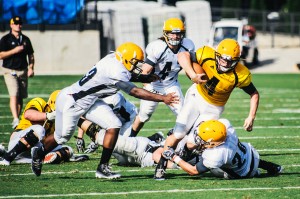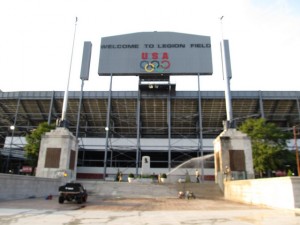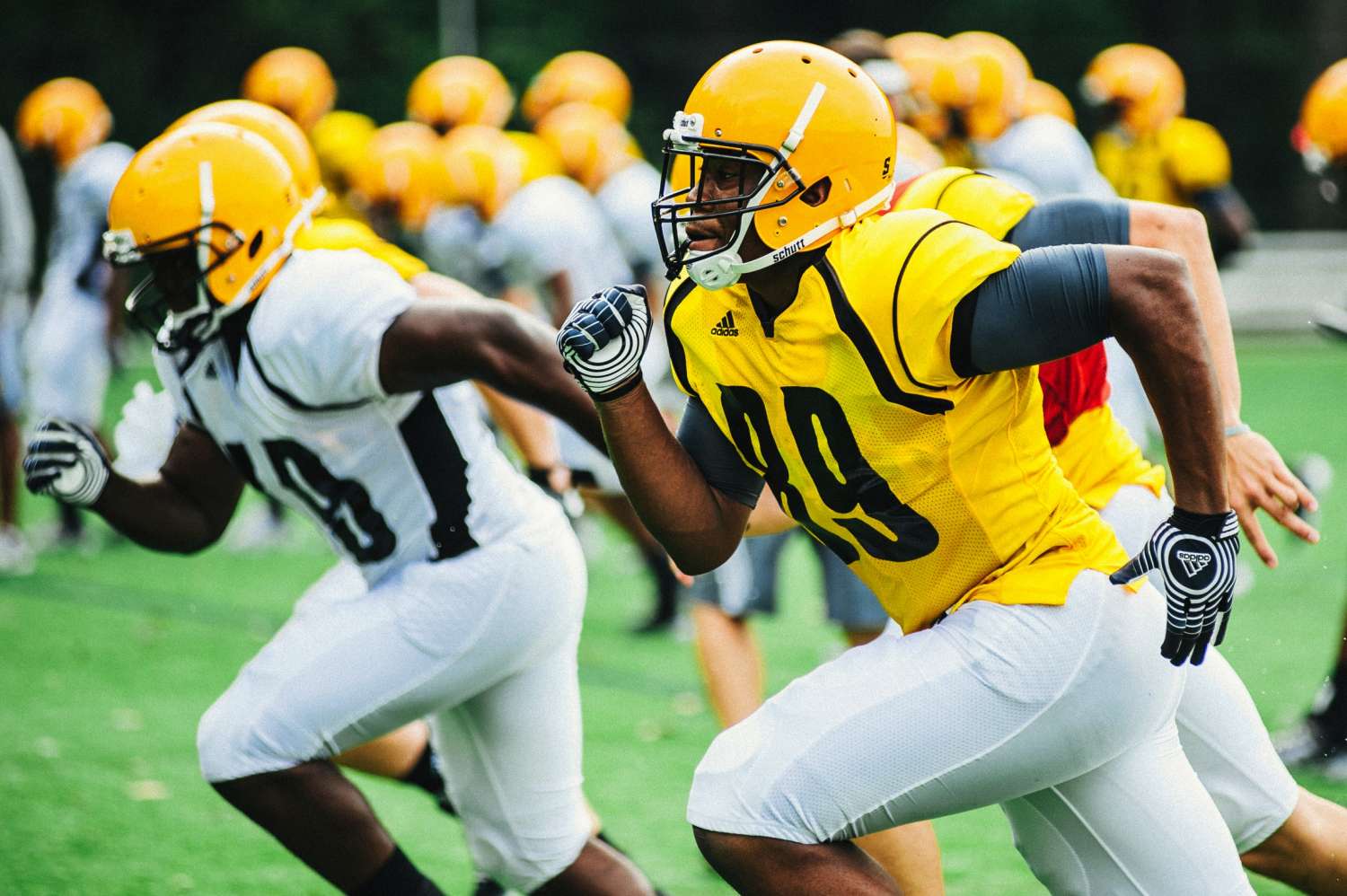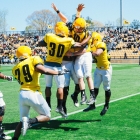
Mike Foster | Staff Writer
Someone, I don’t know who, once said, “What’s one man’s trash is another man’s treasure.”
With a small football program making national headlines for seemingly giving up on football this week, our own school now enters the reality of the college football world.
The University of Alabama at Birmingham’s decision to discontinue its football program, officially announced Tuesday, has been argued as a bad omen to mid-major football programs across the country.
ESPN college football writer Mark Schlabach contended in a column that internal issues such as crimson tie-wearing cronies on the University of Alabama System Board of Trustees and disinterest from school president Ray Watts doomed UAB’s program. Nonetheless, rising operating budgets for college athletic programs that participate at the Football Bowl Championship (FBS) level and further uncertainty burdening the hearts of non-Power 5 conferences have thinned the icy pathway between humble programs and self-sustaining institutions like Texas, Florida, Ohio State and the like.
You might be wondering where Kennesaw State fits into this conversation. Truthfully, KSU and UAB have a lot of in common. Both are second-tier, state-run schools that have had to comply with university system boards when running athletic programs. The difference is that while UAB is shutting its football program down, KSU is looking toward a bright future in which the addition of football will help enhance the presence of the university. KSU’s football team is now on the same operating schedule as every other college football team not set to compete in a bowl this year, with kickoff coming Sept. 3, 2015, against another new program in East Tennessee State.
KSU’s start begs the question: Is it worth the leap of faith to try to join the big boys in the FBS, or will Power 5 autonomy and new mandates for full cost of attendance, set to become the law of the land in 2016 in the wake of the Ed O’Bannon vs. NCAA case, hurt the financial stability of programs that are stuck in limbo between FBS status and actually surviving withwithout losing money in the process.
KSU head coach Brian Bohannon already gave us a pretty stern answer. When speaking to the Georgia Sports Writers Association on June 11, 2013, Bohannon told those in attendance that he was completely resistant to the idea of jumping to the FBS.
“We have no other vision than being the best FCS team we can be,” Bohannon said. I’d assume “we” mean’t the endorsement of the statement from Director of Athletics Vaughn Williams, who told me in a meeting this past summer that Power 5 autonomy and the growing differences and business factors in college athletics were something he welcomed–committing dearly to the idea that whole KSU will remain a humble, community-driven athletic department, the growing passion for KSU athletics would remain a well-lit fire.
“We’re different than, let’s say, a Georgia, and they are different from us. There’s no pretending. I don’t see a problem with that,” Williams said.
But the college sports world has shaken up a lot, and a tug of war of ideals exists between conservatively establishing a program at the FCS level and becoming a national brand.
Some teams have done just that: Boise State is the grandest name in mid-major football. The Broncos joined the FBS in 1997 as a nobody. Ten years later they defeated Oklahoma in the Fiesta Bowl. Now Boise State is a household name. Schools like Baylor, TCU, and Central Florida–all irrelevant in the college football landscape ten years ago–have played in or are on the cusp of BCS Bowls.
But there’s a darker side to this as well: Boise State nearly joined the American Athletic Conference, formerly the Big East, just a few seasons ago. UCF is now considered a juggernaut in the AAC, but only because former teams that drove the value of that conference–Miami (FL), Virginia Tech, Louisville, Syracuse, Pittsburgh–left it for the Atlantic Coast Conference in the past few decades.
Louisville, Syracuse and Pittsburgh’s more recent departures were in haste to conglomerate into a Power 5 conference knowing full well that keystones of college football were about to, well, eat up college football.
The greatest difference between FBS and FCS is that FBS schools offer 80 scholarships, all in full, while FCS schools only offer 63 funded scholarships that can be divided into partial rewards–as they often are. FCS players pay their way through college many a time, and none of them are big names in the national media due to the absence of demand from media networks to televise, cover and promote these programs.
While one division is a true amateurism sport, the other is a business that transcends the purpose of being a student athlete, in general.
UAB was caught in that limbo. As a smaller school, outside the Power 5, the requirement to offer full grant and aid to 80 scholarship players, to build an on-campus stadium and to exist in an era where larger schools are expected to stop scheduling smaller ones in de facto “paycheck” games became too heavy to stick to the wall.

Was there disinterest within the school itself? Yes.
And that’s where Kennesaw State has a fighting chance. President Daniel S. Papp is no Ray Watts; Papp has been very engaged in the process and enthusiasm surrounding KSU football.
We have a home stadium and world class facilities that will become a driving force, if they have not already, in recruiting. When you look at the Big South, KSU’s conference that it will participate in as an associate member in its first few seasons, the Owls already offer more than Charleston Southern, Presbyterian and Monmouth.
Despite being a 30,000 student school, KSU would have to jump a lot of hurdles to take the risk at becoming a stable FBS program: Fifth Third Bank Stadium, which was built with a second phase in mind, would need that second phase to increase capacity near 20,000. KSU would need a significant increase in revenue to have the ability to afford 80 full scholarships, including full cost of attendance under new NCAA bylaws.
But KSU is starting with so much more than most programs do. While KSU ranks 167 out of 230 Division I institutions in revenue, KSU’s total revenue has multiplied from approximately $4 million to $12 million since 2005.
RELATED: Database of College Athletic Program Finances (via USA Today)
In nine years, the program has grown three times larger as a Division I program.
And, honestly, it feels primed to be in great position to take that next jump. Because, unlike UAB, the other programs treading carefully in the waters of FBS football are doing it with the internal enthusiasm and support that UAB so seemingly lacked.
It’s nice to dream of KSU joining the Conference USA, or American Athletic Conference, or even the Sun Belt–like Georgia Southern and Georgia State have done, to different degrees of success–and possibly becoming that next big time buster during water cooler conversations.
In reality, KSU will have a few years of humble Big South football before its affiliate membership runs out. At that time, the department would likely try to move into a new FCS conferene as a whole, such as the Big South as a full member, or another.
Or, KSU could continue its tradition of getting good at things fast and making the broad jump that UAB so conservatively avoided.
The difference between a UAB and a Boise State, a Central Florida or, maybe even, a KSU, is ambition.
But it’s also a conversation of the type of ambition.
Brian Bohannon has ambition. Vaughn Williams has ambition. They want this program to be the next North Dakota State, and while you may not know what that means, it’s a fantastic goal.
But could KSU actually second guess its pathway in the next few years?
While FCS football is well respected in its own right, it’s different. A lot different. And with the gap between FCS and FBS access closing with each UAB situation, court ruling and union discussion, the next decade or so could be the last to offer invitation to the big dance.
I would not be shocked if leaders at KSU have to sit down in the near future and discuss becoming a part of that world.



